Top 12 Metal Fabricator Skills to Put on Your Resume
In metal fabrication, the right skills aren’t just nice-to-have. They move parts, schedules, and careers. The following 12 skills show employers you can read the work, run the tools, and finish clean under pressure.
Metal Fabricator Skills
- MIG Welding
- TIG Welding
- Plasma Cutting
- CNC Machining
- AutoCAD
- SolidWorks
- Metal Finishing
- Blueprint Reading
- Press Brake Operation
- Laser Cutting
- Oxy-fuel Cutting
- Sheet Metal Forming
1. MIG Welding
MIG welding (GMAW) uses a consumable wire and shielding gas to join metals with speed and consistency. It’s a workhorse process for mild steel, stainless, and aluminum across fabrication shops and production lines.
Why It's Important
MIG delivers strong, tidy welds with high deposition rates and forgiving technique, making it ideal for thin sheet, thick plate, and everything in between.
How to Improve MIG Welding Skills
Dial in setup and repeat the right motions until they’re second nature.
Torch position and travel: Use a 10–15° push angle for solid wire. Keep stick-out around 3/8–1/2 in (10–12 mm). Watch the puddle edges; adjust speed to avoid undercut or excessive buildup.
Match settings to transfer mode: Short-circuit for thin stock and out-of-position work; spray or pulsed spray for thicker sections and cleaner beads. Pair voltage and wire feed to the material and wire diameter.
Shielding gas and wire: For mild steel, 75/25 Ar/CO2 is a solid go-to; move toward higher argon for spray transfer. ER70S-6 is common and tolerant of light mill scale; ER70S-3 suits very clean material. Use 100% argon and a spool gun for aluminum.
Maintenance: Clean nozzles, change contact tips, check liners, and set drive roll tension correctly. Poor feeding wrecks arc stability.
Fit-up and fixtures: Consistent gaps, tacks, and clamping reduce distortion and rework.
Safety: Ventilation, fume extraction, gloves, jacket, and a proper shade lens—every time.
How to Display MIG Welding Skills on Your Resume
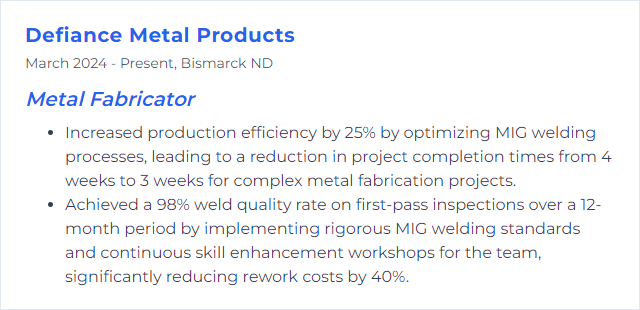
2. TIG Welding
TIG (GTAW) uses a non-consumable tungsten electrode with inert gas shielding for precise, clean welds. It shines on thin materials, exotic alloys, and visible joints where appearance matters.
Why It's Important
It offers exceptional control—puddle size, heat input, and bead profile—producing meticulous welds on stainless, aluminum, and delicate assemblies.
How to Improve TIG Welding Skills
Preparation: Degrease, remove oxides, and keep a dedicated brush for stainless and aluminum. Contaminants show up instantly in TIG.
Tungsten and polarity: For steels, DCEN with 2% lanthanated works well; grind longitudinally to a point. For aluminum, use AC with proper balance and frequency; balling is unnecessary with modern inverters.
Heat control: Foot pedal or fingertip control keeps the puddle stable. Minimize dwell to reduce distortion and discoloration.
Filler selection: Match rod to base metal (e.g., ER70S-2 for carbon steel, ER308L for 304 stainless, 4043/5356 for aluminum) and size to the joint.
Technique: Hold a tight arc length; keep the torch angle shallow and consistent. Add filler at the leading edge of the puddle.
Gas coverage: Right cup size, gas lens when needed, and adequate post-flow to protect the tungsten and crater.
How to Display TIG Welding Skills on Your Resume

3. Plasma Cutting
Plasma cutting uses a constricted, ionized gas jet to slice conductive metals with speed and accuracy. Handheld or CNC, it’s built for fast profiles and clean edges.
Why It's Important
It reduces layout time, handles complex shapes, and keeps throughput brisk without costly tooling.
How to Improve Plasma Cutting Skills
Dry, clean air: Moisture kills consumables and cut quality. Use a dryer and filters.
Correct standoff and pierce height: Maintain torch height with a drag shield or height control. Set pierce delay to match thickness.
Travel speed: Look for minimal dross and near-vertical kerf walls. Drag lines should be almost straight.
Consumables: Replace electrodes and nozzles before quality drops. Keep spares sorted by thickness range.
CNC optimization: Tune lead-ins/lead-outs, corner loops, and kerf compensation. Nest parts to save material.
Grounding and safety: Solid work clamp, good cable integrity, and proper PPE.
How to Display Plasma Cutting Skills on Your Resume

4. CNC Machining
CNC machining drives mills, lathes, and other tools through programmed motions, shaping metal parts with repeatable precision.
Why It's Important
It delivers tight tolerances, consistent finishes, and scalable output—vital for prototypes through production runs.
How to Improve CNC Machining Skills
Toolpaths that think: Use adaptive/HEM strategies, rest machining, and proper stepovers to extend tool life and slash cycle times.
Right tooling, right holders: Pick geometry and coatings for the alloy; use balanced, rigid holders and minimize stick-out.
Fixturing: Rigid workholding reduces chatter and variation. Add locators for quick, repeatable setups.
Coolant and chips: Through-spindle or high-pressure coolant helps. Manage chip evacuation, especially in deep pockets.
In-process probing: Automate setup, verify features, and update work offsets on the fly.
Preventive and predictive care: Keep machines aligned, ballscrews lubricated, and spindles healthy. Monitor vibration and load to catch issues early.
Simulation and post checks: Verify code, avoid gouges, and confirm safe rapids before a single cut.
How to Display CNC Machining Skills on Your Resume
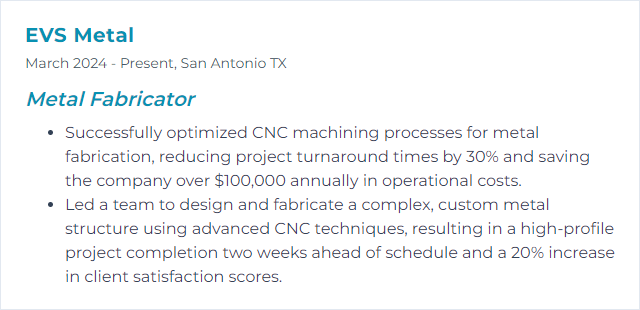
5. AutoCAD
AutoCAD enables precise 2D/3D drafting for parts, assemblies, jigs, and shop layouts. Fast edits, clear output, fewer surprises on the floor.
Why It's Important
Accurate drawings cut rework, streamline communication, and keep fabrication aligned with intent.
How to Improve AutoCAD Skills
Templates and standards: Title blocks, layers, dim styles, and plot settings—baked in and enforced.
Blocks and dynamic blocks: Reuse features with parameters and visibility states to speed repetitive detailing.
Sheet Set Manager: Drive multi-sheet projects, revision control, and batch printing from one hub.
Parametric constraints: Lock intent so geometry updates intelligently instead of unraveling.
Xrefs: Reference large assemblies and keep files lean while teams collaborate.
Data extraction: Push part properties into tables for BOMs and cut lists without manual typing.
Shortcuts and customization: Tool palettes, aliases, and scripts tame repetitive work.
How to Display AutoCAD Skills on Your Resume

6. SolidWorks
SolidWorks offers parametric 3D modeling, drawings, and simulation—perfect for sheet metal, weldments, machined parts, and assemblies that must fit on the first try.
Why It's Important
You can design, check, and hand off flat patterns, DXFs, and drawings that flow straight to the shop.
How to Improve SolidWorks Skills
Sheet metal mastery: Set K-factors, bend tables, and reliefs correctly; generate flat patterns that cut clean and bend right.
Weldments: Structural members, trim/extend, and cut lists keep frames tight and fast to detail.
Configurations: Variants of a part or assembly without copy chaos. Drive hardware lengths, cuts, and options.
Design for manufacturing: Align hole sizes to standard tools, maintain bend radii, and respect minimum flange lengths.
Assembly checks: Mates, interference detection, clearance verification, and exploded views to validate fit and function.
Drawings that work: Use model items, weld symbols, GD&T, and custom properties to populate BOMs automatically.
PDM and MBD: Control revisions and share model-based definitions where drawings are minimal or optional.
How to Display SolidWorks Skills on Your Resume
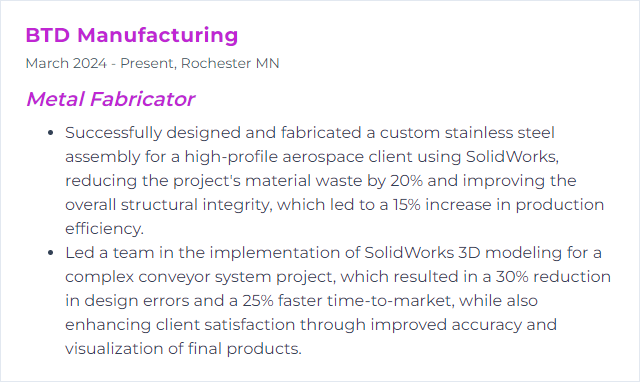
7. Metal Finishing
Metal finishing modifies surfaces—coatings, plating, polishing, conversion layers—to improve corrosion resistance, durability, conductivity, or appearance.
Why It's Important
It’s the last line between a good part and a great product: tougher, cleaner, consistent, and ready for the field.
How to Improve Metal Finishing Skills
Surface prep: Degrease, deoxidize, and blast to a defined profile when needed. Clean parts finish better—every time.
Right process, right alloy: Powder coat, e-coat, anodize, passivate, electroplate—match finish to environment and performance targets.
Process control: Track bath chemistries, cure schedules, film thickness, and temperature. Document settings and hold them.
Masking and edge treatment: Radius sharp corners, mask threads and critical interfaces to avoid buildup and fit issues.
Quality checks: Measure thickness, adhesion, gloss, and perform corrosion testing as required.
Maintenance and safety: Calibrate ovens, maintain spray gear, and follow environmental and chemical handling rules (e.g., hex-chrome alternatives, RoHS/REACH where applicable).
How to Display Metal Finishing Skills on Your Resume

8. Blueprint Reading
Blueprint reading means parsing drawings, notes, and specifications—dimensions, tolerances, materials, processes—so fabricated parts match design intent.
Why It's Important
Without accurate interpretation, even perfect machine work can miss the mark. Fit, function, and compliance start on the page.
How to Improve Blueprint Reading Skills
GD&T fluency: Understand ASME Y14.5 symbols, datums, and tolerance zones. Read feature control frames without guessing.
Weld, finish, and surface symbols: Know AWS weld symbols, surface texture callouts, coatings, and heat treat notes.
Views and sections: Orthographic views, sections, details, and auxiliary projections—grasp what’s hidden and why it matters.
Title block and revisions: Check scales, units, tolerances, and the latest revision before cutting a chip.
Stack-ups and measurement: Calculate tolerance chains; confirm with calipers, micrometers, height gauges, and CMM reports when applicable.
Practice on real prints: Review diverse drawings—sheet metal, machined, weldments—to build speed and confidence.
How to Display Blueprint Reading Skills on Your Resume

9. Press Brake Operation
Press brakes bend sheet and plate using matched tooling and controlled tonnage to hit angles, radii, and flatness targets.
Why It's Important
Accurate forming keeps assemblies square, holes aligned, and downstream operations painless.
How to Improve Press Brake Operation Skills
Know your bend math: Bend allowance/deduction, K-factor, and springback vary by material, thickness, and tooling. Calibrate and record.
Tooling selection: Match punch radius and V-die opening to thickness and desired radius. Air bending vs. bottoming—choose intentionally.
Crowning and backgauges: Use crowning to counter deflection; set backgauges for repeatability and safe clearance.
Grain direction and minimum flange: Form with grain awareness to avoid cracking; respect minimum flange lengths for die access.
Programming and simulation: Offline programming and bend sequencing reduce collisions and handling time.
Tonnage and safety: Verify required tonnage, use guards/light curtains, and keep hands and clamps happy—no shortcuts.
How to Display Press Brake Operation Skills on Your Resume
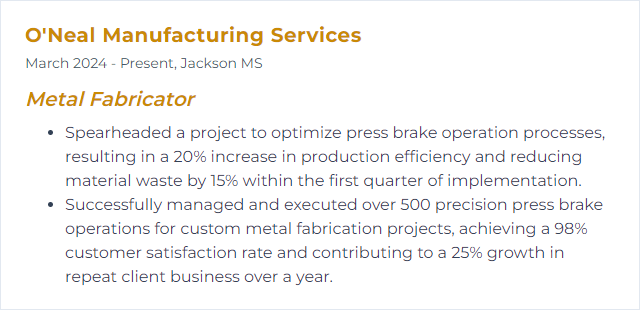
10. Laser Cutting
Laser cutting focuses a high-energy beam to slice metals with crisp edges and tight tolerances. Fiber lasers dominate modern shops for speed and efficiency.
Why It's Important
Intricate geometries, minimal heat-affected zones, and rapid turnaround—laser keeps parts flowing.
How to Improve Laser Cutting Skills
Assist gas strategy: Oxygen for fast carbon steel cutting (oxidizing action), nitrogen for burr-free stainless and aluminum, air for cost-effective general work.
Focus, nozzle, and stand-off: Verify focus position, keep nozzles concentric and clean, and hold a consistent gap.
Parameters that matter: Power, feed rate, frequency, duty cycle, and pierce timing must match thickness and alloy.
Nesting and tabs: Smart nesting saves material; micro-joints prevent tip-ups and keep parts stable.
Kerf and lead-ins: Compensate kerf width; use appropriate lead-in/out styles to protect edges and holes.
Maintenance: Clean optics, dry gas, aligned beam path—quality rides on upkeep.
How to Display Laser Cutting Skills on Your Resume
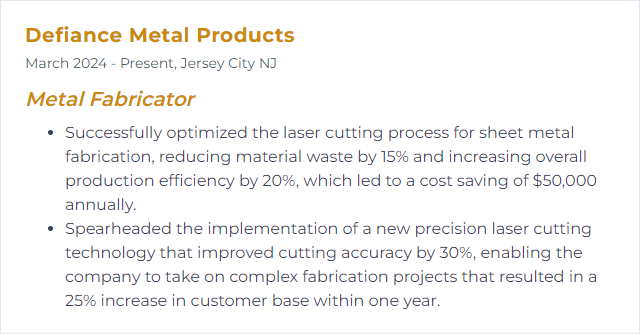
11. Oxy-fuel Cutting
Oxy-fuel cutting preheats carbon steel to ignition temperature, then injects pure oxygen to oxidize and blow away metal. It’s the choice for thick carbon and low-alloy steels. Note: it does not cut stainless or aluminum effectively.
Why It's Important
It’s rugged, portable, and capable of slicing heavy plate where other methods stumble or cost more.
How to Improve Oxy-fuel Cutting Skills
Tip and pressure selection: Match tip size and oxygen/fuel pressures to plate thickness. Set neutral flame for clean preheat.
Preheat and speed: Watch the color and surface reaction; once the cut starts, keep a steady pace to produce straight drag lines and minimal slag.
Nozzle care: Keep orifices clean and concentric. Damaged tips cause rough edges and heavy dross.
Setup and angle: Hold the torch vertical for straight cuts; slight lead angle can help on thicker plate.
Safety: Use flashback arrestors, check for leaks, store cylinders properly, and shield hot slag. Ventilation matters.
How to Display Oxy-fuel Cutting Skills on Your Resume
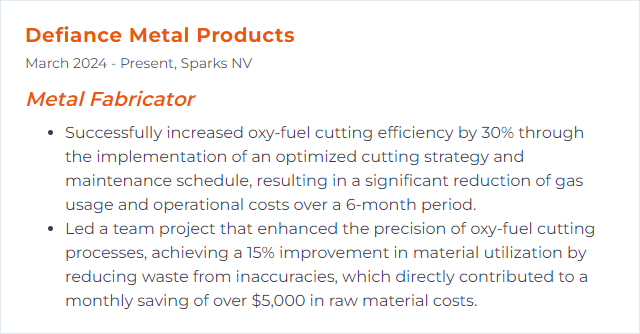
12. Sheet Metal Forming
Sheet metal forming bends, draws, flanges, hems, and stretches flat stock into functional shapes without removing material.
Why It's Important
It creates lightweight, strong parts efficiently—brackets, enclosures, panels, and frames that assemble without drama.
How to Improve Sheet Metal Forming Skills
Design rules: Respect minimum bend radii, flange lengths, reliefs, and hole-to-bend distances. Plan for grain direction.
Bend calculations: Use correct K-factors, bend allowances, and deductions for accurate flat patterns.
Tooling and lubrication: Select dies and punches to control thinning and wrinkling; lubricate appropriately to reduce galling.
Draws and beads: Manage draw ratios, add draw beads, and preform when needed to tame material flow.
Springback compensation: Overbend or adjust process parameters based on trials and material batches.
Quality and maintenance: Inspect thickness, radii, and angles; keep tools sharp and presses aligned to hold repeatability.
How to Display Sheet Metal Forming Skills on Your Resume

